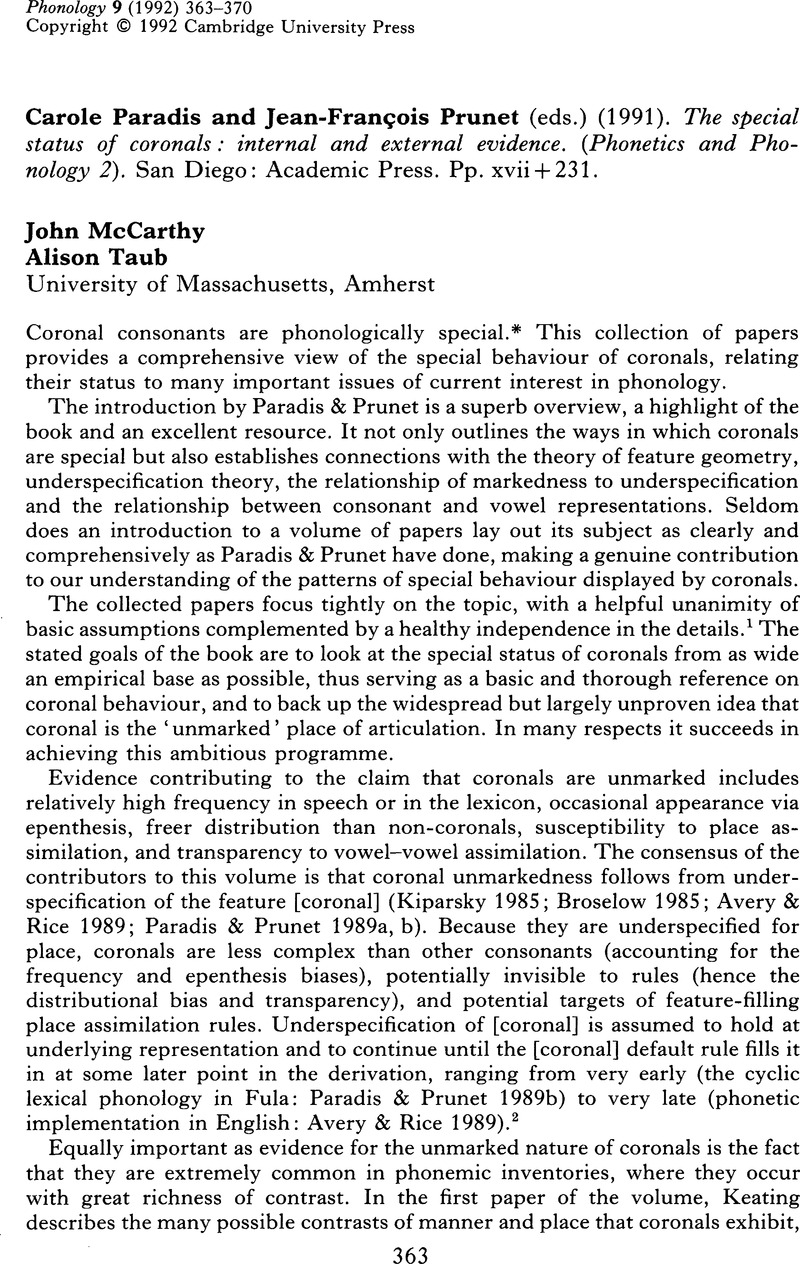Crossref Citations
This article has been cited by the following publications. This list is generated based on data provided by Crossref.
Rice, Keren
1996.
Default variability: The coronal-velar relationship.
Natural Language and Linguistic Theory,
Vol. 14,
Issue. 3,
p.
493.
Hall, T.Alan
1996.
Inalterability and sibilant neutralization in Gujarati.
Lingua,
Vol. 99,
Issue. 1,
p.
11.
Lombardi, Linda
1996.
Postlexical rules and the status of privative features.
Phonology,
Vol. 13,
Issue. 1,
p.
1.
Brown, Cynthia A.
1998.
The role of the L1 grammar in the L2 acquisition of segmental structure.
Second Language Research,
Vol. 14,
Issue. 2,
p.
136.
Halle, Morris
Vaux, Bert
and
Wolfe, Andrew
2000.
On Feature Spreading and the Representation of Place of Articulation.
Linguistic Inquiry,
Vol. 31,
Issue. 3,
p.
387.
2001.
Asymmetries in the Phonology of Miogliola.
p.
233.
Coenen, Else
Zwitserlood, Pienie
and
Bölte, Jens
2001.
Variation and assimilation in German: Consequences for lexical access and representation.
Language and Cognitive Processes,
Vol. 16,
Issue. 5-6,
p.
535.
Morrisette, Michele L.
Dinnsen, Daniel A.
and
Gierut, Judith A.
2003.
Markedness and Context Effects in the Acquisition of Place Features.
Canadian Journal of Linguistics/Revue canadienne de linguistique,
Vol. 48,
Issue. 3-4,
p.
329.
Alderete, John
2004.
Optimality Theory in Phonology.
p.
394.
Blevins, Juliette
2004.
Evolutionary Phonology.
2004.
Optimality Theory.
p.
266.
Prince, Alan
and
Smolensky, Paul
2004.
Optimality Theory in Phonology.
p.
1.
Nevins, Andrew
2007.
The representation of third person and its consequences for person-case effects.
Natural Language & Linguistic Theory,
Vol. 25,
Issue. 2,
p.
273.
McCarthy, John J.
2008.
The gradual path to cluster simplification.
Phonology,
Vol. 25,
Issue. 2,
p.
271.
Scharinger, Mathias
2009.
Minimal representations of alternating vowels.
Lingua,
Vol. 119,
Issue. 10,
p.
1414.
이용성
2009.
Markedness Oriented Candidate Chains.
Korean Journal of Linguistics,
Vol. 34,
Issue. 3,
p.
671.
Kurisu, Kazutaka
2009.
Palatalisability via feature compatibility.
Phonology,
Vol. 26,
Issue. 3,
p.
437.
Finley, Sara
2010.
Exceptions in vowel harmony are local.
Lingua,
Vol. 120,
Issue. 6,
p.
1549.
Lahiri, Aditi
and
Reetz, Henning
2010.
Distinctive features: Phonological underspecification in representation and processing.
Journal of Phonetics,
Vol. 38,
Issue. 1,
p.
44.
Archangeli, Diana
2011.
The Blackwell Companion to Phonology.
p.
1.





